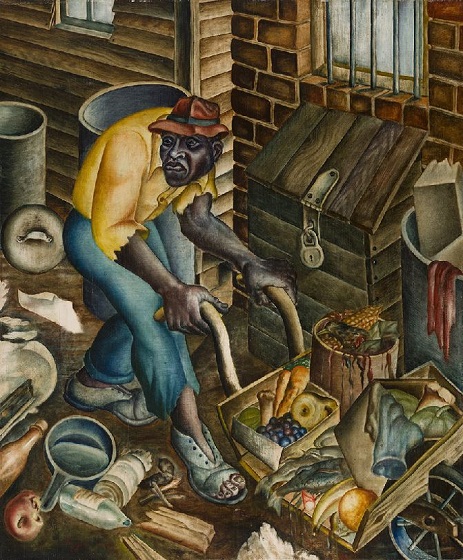
John Anansa Thomas Biggers, 1924 – 2001
The Garbage Man, 1944
Oil on panel
Crystal Bridges Museum of American Art, Bentonville, Arkansas
Today’s blog post was prepared by Crystal Bridges Interpretation intern Dennison Schultz.
New to the Crystal Bridges permanent collection is The Garbage Man (1944) by John Biggers (1924 – 2001). The painting, as one of his early works, was completed when the artist was only nineteen years old!
Born and raised in North Carolina, John Biggers started drawing in the boiler room of Lincoln Academy, where he both worked and attended school. He included these drawings in his application to study plumbing at the Hampton Institute in Virginia, but he quickly turned to art under the direction of professor Viktor Lowenfeld, who encouraged Biggers and his classmates to express the social realities, good or bad, of their African American communities. Biggers’s education at the Hampton Institute also introduced him to African cultures and many of his art influences, including American Regionalists, Mexican muralists like Diego Rivera, writers Dr. Alain Locke and W. E. B. Du Bois, painter Charles White, and sculptor Elizabeth Catlett.
Biggers was drafted into the Navy in 1943 as an artist, assigned to crafting training models of military machinery. When he was honorably discharged two years later, Lowenfeld encouraged Biggers to enroll at Pennsylvania State, where Biggers would eventually earn his bachelor’s, master’s, and doctorate degrees. This change in setting revealed to the artist the differences between Southern and Northern African American communities, and the pieces he painted during this period, in contrast to his earlier work, portrayed the realities of black urban experiences with poverty. His style—the exaggerated anatomy and perspective that we see in The Garbage Man—enhances Biggers’s storytelling of these experiences.
Texas Southern University hired Biggers as Chairman of the Art Department in 1949, where he built the department from the ground up. Although his work had been included in several exhibitions prior to his appointment, he established himself as a professional artist while at TSU, winning three major prizes in his first three years. His successes were not without racist pushback. When Biggers won a purchase prize from the Museum of Fine Art, Houston, in 1950 for The Cradle, the museum blocked his attendance to the opening ceremony because African Americans were only allowed inside the building on Thursdays.
Biggers continued to gain national recognition and evolve as an artist. His drawing, painting, and mural style changed considerably following a UNESCO fellowship in 1956 that allowed him to travel to Africa, and Biggers became one of few people in America depicting African cultures in a positive light. These works were heavily geometric and praised African and African American women for their crucial contributions to the world. His book, Ananse: The Web of Life in Africa, published in 1962, became a major source of hope and promise for black activists during the Civil Rights Movement and indicated a new direction for black creativity. By this time, Biggers had established a clear visual vocabulary and belief system throughout his work based on spiritual values for enlightenment, cultural traditions, and social structures.
John Biggers dedicated his work to preserving the experiences of African and African American communities, never shying away from difficult social truths, and always eager to celebrate his culture’s great joys.
Sources: (You can find these and many more great books about American art and artists in the Crystal Bridges Library!
John Biggers: My America by John Biggers, Whitfield Lovell, and Michael Rosenfeld Biggers
The Art of John Biggers: View from the Upper Room by Alvia J. Wardlaw




